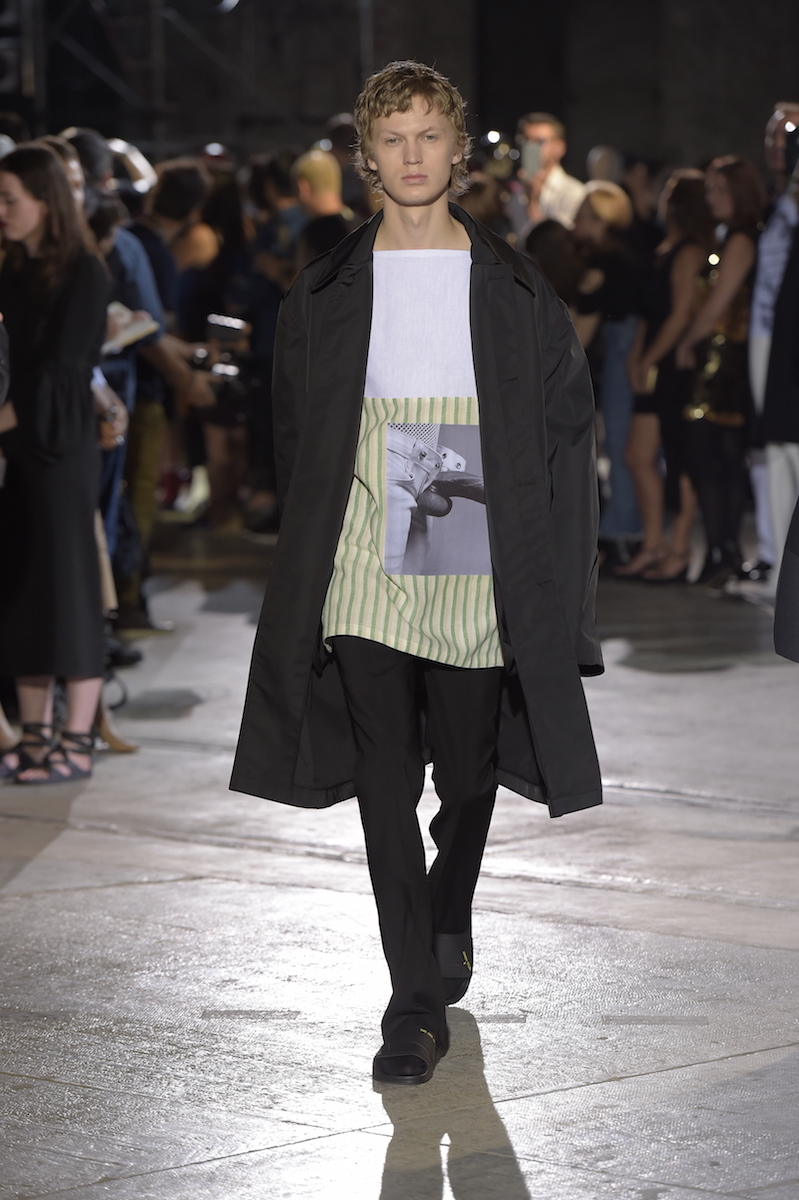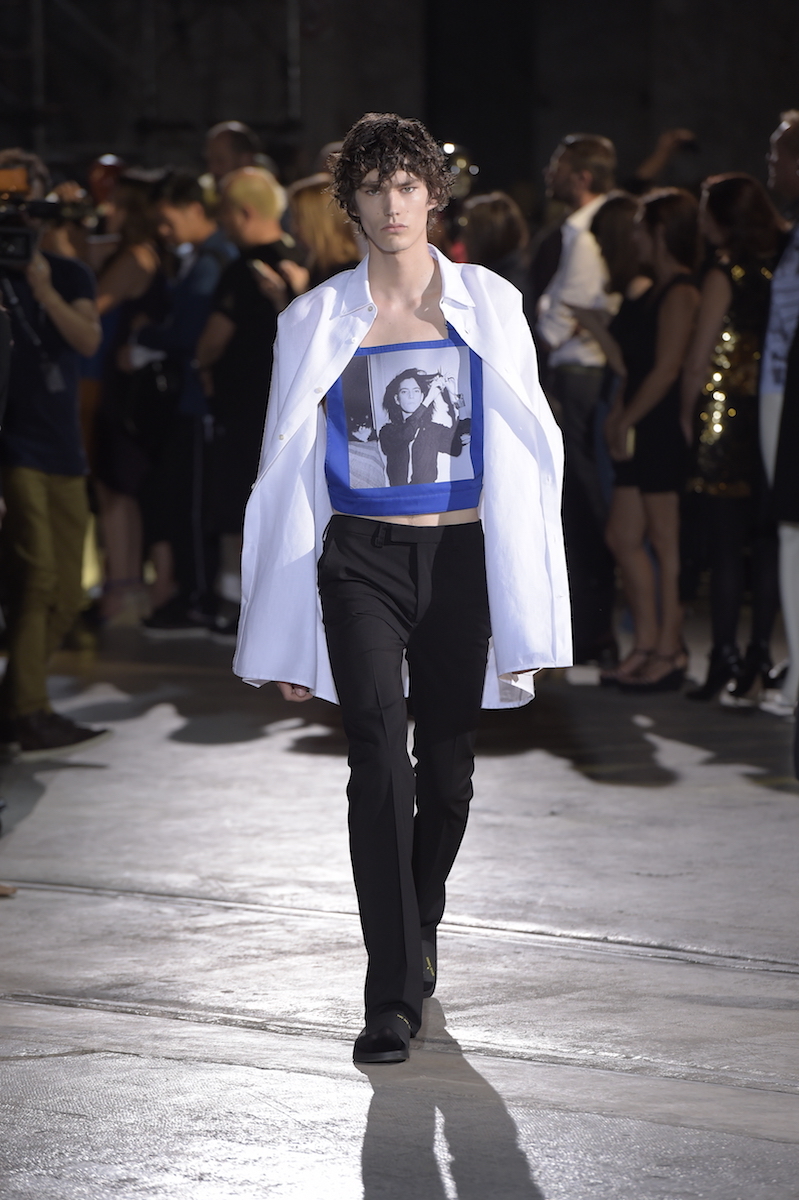Art-on-art. It’s a recurring theme in Florence during the twice-yearly Pitti Immagine fashion week where the masterpieces of the city — from Renaissance to fascist architecture and everything that lives inside — is suddenly used as a backdrop for new creations. It’s what Pucci did in 2014 when the brand covered the Duomo’s Baptistry in a huge scarf, or what Karl Lagerfeld did this season when he exhibited his photographs on top of the Renaissance masters hanging in Palazzo Pitti. For his third time at the Florentine rodeo — fourth if you count his Jil Sander show in 2010 — Raf Simons went back to the building in which it all began: the dilapidated Stazione Leopolda where, in 1998, he built an all-white apartment and had three Raf Simons-clad boys living in it for the duration of the installation. In 2005, he celebrated the tenth anniversary of his brand with a retrospective and show at the Boboli Gardens. True to Florentine manner — and certainly to the spirit of Pitti — the spring/summer 17 collection he presented at Stazione Leopolda on Thursday evening was a meeting between art forms and crafts. Mannequins wearing his archive pieces had already taken their seats and spots for the show as guests walked into the enormous venue, and when Michel Gaubert pressed play on Klaus Nomi’s take on “The Cold Song” from Purcell’s King Arthur, skinny and pale boys trotted through the masses with photos on their clothes. They were the work of Robert Mapplethorpe.

“I wanted to do a show where every boy is the representation of one work. I wanted to approach it very curatorially, like you would a museum show, which was often done by other people when it comes to Mapplethorpe’s work — but always in a gallery: always in the same kind of context and form. So I thought the biggest challenge for me would be not to show his work in a gallery but in relation to my own environment. And they immediately found that very challenging and interesting,” Simons said after the show, wearing a paint-splattered shirt from his previous artist collaboration with Sterling Ruby. He’d been approached by Mapplethorpe’s Estate, spent two afternoons flicking through the archive of categorized books — “famous people, black guys, flowers, self-portraits, polaroids” — and decided to go all in. “I was familiar with a lot of the work but there was also a lot of work I’d never seen. I was quite struck by the impact on me of certain people that he photographed: artists I admire who’ve passed away, like Alice Neel, for example. I very much love the Willem de Kooning, and I told them it was very important to juxtaposition that kind of work with work that we all know, as well as the work he got criticized for, like the sex scenes. It got banned in museums. I think it’s important to show all the work.” And so he did, including the most elegant dick pic ever taken, proudly carried on a top by Jonas Gloer, who has himself posed naked for Willy Vanderperre — also in attendance — in the past.

With photos featured on garments Raf style, his exercise in Mapplethorpism wasn’t art-on-art the way we’ve so often seen it in Florence, but rather art-on-craft. He framed the photographer’s portraits with his garments several times over, adding roomy coats and shirts and knits over tops revealing the works. But Mapplethorpe himself was in there, too, in tamed, untamed manes and leather porter caps. “When you look at Mapplethorpe’s work it’s also so much about him. With some artists their personalities don’t connect to the work, but in his case it does. He could even shoot a flower very sexually, so you have to take that in and give it serious consideration,” Simons said. (He’d been given free roam of the archive, although he had to get the permission of every portraitee featured, some of which couldn’t be tracked down.) The show was the final piece in the designer’s Pitti trilogy: his series of visits to the Florentine fashion week, which has meant a great deal to his work and the premise of which he understands better than any other designer. “I came back because of the people. They support you and you can do a bit more,” Simons said. Florence is hometown to some of history’s most important artist and designers. The city is about creation, and always about the fusion of the past and the present.

This was exactly what Simons did with his Mapplethorpe collection, but it also showed a great understanding on his part of the boys, who are going to buy it. “For me it’s not so important that everything is explained and analyzed. If it works it works. I wanted to challenge myself for the Estate to make it believable hopefully to a different audience that wouldn’t see Mapplethorpe’s work in a gallery, contextually and curatorially. And also, I reach out to different generations, I think. Not only to people who know a lot about art.” In this industry the eternal discussion remains: is fashion art? Some of us would lean towards a no, and that was the best part about Simons’ collection. It didn’t try to incorporate those Mapplethorpes into the garments, but rather display them on the garments in an appreciative way, which was ultimately quite innocent. It was fan art — Mapplethorpe merchandise — but the kind that will open the eyes of a new generation to one of the twentieth century’s most influential photographers.

Credits
Text Anders Christian Madsen
Photography courtesy of Raf Simons
